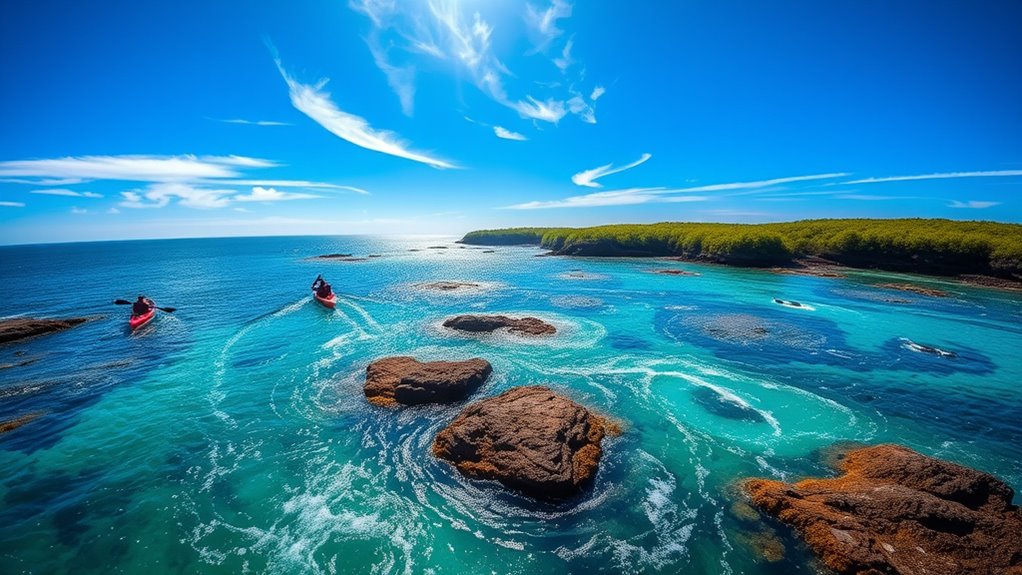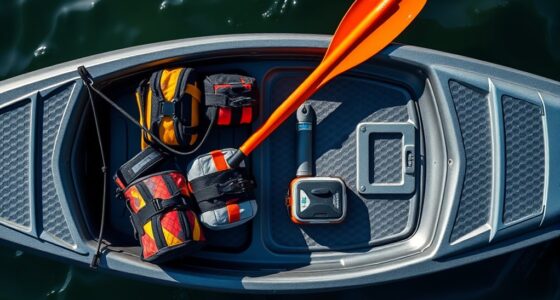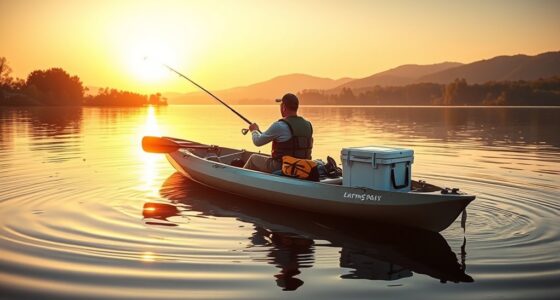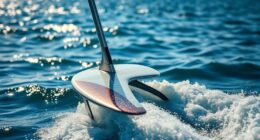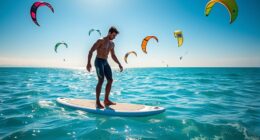Understanding tidal streams is essential for your coastal kayaking adventures. These currents shape your paddling experience, either boosting your speed or creating challenging conditions. By studying tide charts, you’d know when to launch and how to harness incoming tides. Always wear your life jacket and keep safety gear handy. Pay attention to signs like ripples and foam to navigate strong currents effectively. Get ready to enhance your kayaking skills as you explore these fascinating tidal dynamics.
Key Takeaways
- Tidal streams are influenced by the gravitational pull of the moon and sun, creating currents that affect paddling conditions.
- Reading tide charts helps identify high and low tides, as well as current strength and direction for trip planning.
- Always wear a life jacket and carry safety gear to ensure preparedness for changing conditions while kayaking.
- Observe water surface signs like ripples or foam to identify strong currents and navigate them safely.
- Familiarize yourself with local marine navigation rules and potential hazards to enhance safety and enjoyment while paddling.
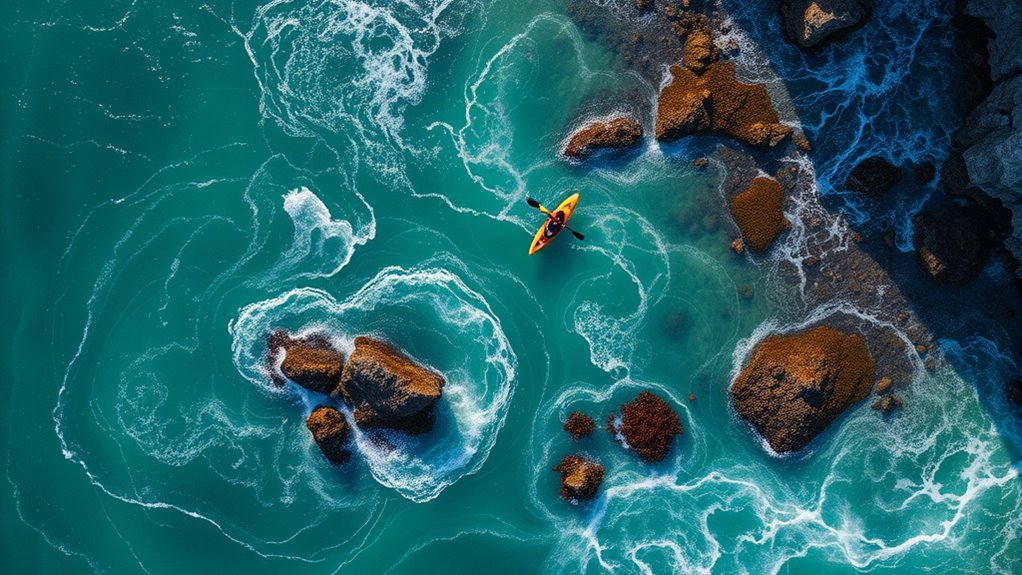
When you head out for a day of coastal kayaking, understanding tidal streams can make a significant difference in your experience. Tidal streams, driven by the gravitational pull of the moon and sun, create currents that can either assist or challenge your paddling. Knowing how to read these streams allows you to enhance your marine navigation skills, ensuring you stay safe and enjoy your time on the water.
Before you set off, it’s essential to check the local tide charts. These charts provide crucial information about high and low tides, as well as the strength and direction of the currents. If you paddle against a strong outgoing tide, you might find yourself struggling to make progress. Conversely, if you time your departure with the incoming tide, you can harness the current to glide effortlessly along the coast. This knowledge not only enhances your efficiency but also helps you conserve energy throughout your trip.
Safety precautions are paramount when navigating tidal streams. Always wear your life jacket, and make sure your kayak is equipped with safety gear like a whistle and a light for visibility. It’s also wise to let someone know your planned route and expected return time. In case of unexpected changes in the tide or weather, having a safety plan in place is crucial. You should also consider paddling with a buddy; two heads are better than one when assessing conditions.
As you paddle, keep an eye on the water’s surface and the surrounding environment. Look for signs of changing currents, such as ripples or foam. These indicators can help you identify where the strongest flows are located. If you find yourself in a particularly strong current, don’t panic. Instead, maintain a steady course and use your paddling technique to navigate through it. Remember, the key is to stay calm and assess your options.
Lastly, familiarize yourself with the local marine navigation rules. Knowing where you’re allowed to paddle and what areas may be restricted is important for both your safety and the environment. Being aware of potential hazards, such as rocks and boat traffic, will help you avoid accidents. With a good understanding of tidal streams and the necessary safety precautions, your coastal kayaking adventure can be both thrilling and safe. Embrace the currents, and enjoy the beauty of the coast! Additionally, understanding the role of color accuracy in your gear can enhance your overall experience on the water.
Frequently Asked Questions
What Equipment Do I Need for Kayaking in Tidal Streams?
For kayaking in tidal streams, you’ll need essential kayaking gear like a quality kayak, a paddle, and a personal flotation device (PFD). Don’t forget a spray skirt to keep water out and a whistle for safety. A map or GPS device helps you navigate currents, while a dry bag protects your belongings. Always check the tides and currents beforehand to guarantee tidal stream safety, and consider wearing a wetsuit for extra protection.
How Do I Find Tidal Stream Maps for My Area?
To find tidal stream maps for your area, check online resources like NOAA’s website or local maritime agencies for tidal stream charts. You can also use navigation apps, such as Navionics or Tide Charts, which often include interactive maps and real-time data. These tools will help you plan your kayaking trips effectively by showing you current tidal conditions and stream patterns. Don’t forget to download them before heading out!
Are There Specific Safety Gear Requirements for Tidal Kayaking?
When starting on your tidal kayaking adventure, you’ll want to make sure you’re properly equipped. Think of it as a well-prepared journey rather than just a trip. You’ll need a personal flotation device, a whistle, and appropriate clothing. Consulting tide charts and attending safety briefings can enhance your experience. Always carry a first aid kit and a means of communication. With these essentials, you can navigate the waters with confidence and peace of mind.
Can Beginners Safely Kayak in Tidal Streams?
Yes, beginners can safely kayak in tidal streams, but you need to conduct a thorough beginner risk assessment first. Familiarize yourself with tidal current dangers, like sudden changes in current strength and direction. Always check the tide schedule, wear a personal flotation device, and consider going with an experienced kayaker. Start in calmer conditions, and practice your skills before tackling stronger streams. Your safety should always come first while enjoying kayaking adventures!
What Are the Best Times of Year for Tidal Kayaking?
The best times for tidal kayaking are spring and fall, much like a bird’s migration, where you can witness nature at its finest. During these seasons, you’ll enjoy mild temperatures and vibrant wildlife, making your adventure more memorable. Spring brings blooming flowers and active wildlife, while fall offers stunning foliage and migrating birds. Keep an eye on seasonal weather patterns to guarantee safety and maximize your experience on the water.
Conclusion
As you paddle through the shimmering waters, remember that tidal streams are like the whispers of the ocean, guiding you on your journey. Embrace their rhythm, and you’ll find not just a path, but a dance with nature itself. Each ebb and flow is an invitation to explore, to connect, and to discover the hidden treasures along the coast. So, let the tides be your compass, and set forth into the beauty that awaits just beyond the horizon.

